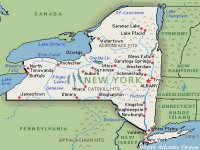|
Welcome to New York!
New York's borders touch (clockwise from the west) two Great Lakes (Erie and Ontario, which are connected by the Niagara River); the provinces of Ontario and Quebec in Canada; Lake Champlain; three New England states (Vermont, Massachusetts, and Connecticut); the Atlantic Ocean, and two Mid-Atlantic States, New Jersey and Pennsylvania. In addition, Rhode Island shares a water border with New York. Contrasting with New York City's urban atmosphere, the vast majority of the state is dominated by farms, forests, rivers, mountains, and lakes. New York's Adirondack Park is the largest state park in the United States. It is larger than the Yellowstone, Yosemite, Grand Canyon, Glacier and Olympic National Parks combined. New York established the first state park in the United States at Niagara Falls in 1885. Niagara Falls, on the Niagara River as it flows from Lake Erie to Lake Ontario, is a popular attraction. The Hudson River begins with Lake Tear of the Clouds and flows south through the eastern part of the state without draining Lakes George or Champlain. Lake George empties at its north end into Lake Champlain, whose northern end extends into Canada, where it drains into the Richelieu and then the St. Lawrence Rivers. Four of New York City's five boroughs are on the three islands at the mouth of the Hudson River: Manhattan Island, Staten Island, and Brooklyn and Queens on Long Island. Upstate and downstate are often used informally to distinguish New York City or its greater metropolitan area from the rest of New York state. The placement of a boundary between the two is a matter of great contention. Unofficial and loosely defined regions of Upstate New York include the Southern Tier, which often includes the counties along the border with Pennsylvania and the North Country, which can mean anything from the strip along the Canadian border to everything north of the Mohawk River As of 2006, New York was the third largest state in population after California and Texas, with an estimated population of 19,541,453 as of July 1, 2009. This represents an increase of 513,481, or 2.7%, since the last census in 2000. It includes a natural increase since the last census of 803,680 people (that is 2,072,765 births minus 1,269,085 deaths) and a decrease due to net migration of 698,895 people out of the state. Immigration from outside the United States resulted in a net increase of 876,969 people, and migration within the country produced a net loss of 1,575,864 people. The center of population of New York is located in Orange County, in the town of Deerpark. New York City and its eight suburban counties (excluding those in New Jersey, Connecticut, and Pennsylvania) have a combined population of 13,209,006 people, or 68.42% of the state's population. The major ancestry groups in New York state are African American (15.8%), Italian (14.4%), Irish (12.9%), and German (11.1%). According to a 2004 estimate, 20.4% of the population is foreign-born. New York is home to the largest African American population and the second largest Asian American population in the United States. In addition it is home to the largest Puerto Rican, Dominican and Jamaican American populations in the continental United States. The New York City neighborhood of Harlem has historically been a major cultural capital for African-Americans of sub-Saharan descent, and Bedford Stuyvesant is the largest such population in the United States. Queens, also in New York City, is home to the state's largest Asian-American population, and is also the most diverse county in the United States. The second concentration of Asian-Americans is in Manhattan's Chinatown. Queens is home to the largest Andean population (Colombian, Ecuadorian, Peruvian and Bolivian) population in The United States of America. In the 2000 Census, Italian Americans made up the largest ancestral group in Staten Island and Long Island, followed by Irish Americans. Albany and southeast-central New York also have populations with many of Irish-American and Italian-American descent. In Buffalo and western New York, German Americans are the largest group; in the northern tip of the state, French Canadians are. New York State has a higher number of Italian Americans than any other U.S. state. 6.5% of New York's population were under 5 years of age, 24.7% under 18, and 12.9% were 65 or older. Females made up 51.8% of the population. According to the 2000 U.S. Census, 13.61% of the population aged 5 and over speak Spanish at home, while 2.04% speak Chinese (including Cantonese and Mandarin), 1.65% Italian, and 1.23% Russian. The largest city in the state and the most populous city in the United States is New York City, which comprises five counties, the Bronx, New York (Manhattan), Queens, Kings (Brooklyn), and Richmond (Staten Island). New York City is home to more than two-fifths of the state's population. The ten largest cities are: New York City (8,274,527), Buffalo (279,745), Rochester (211,091), Yonkers (196,425), Syracuse (141,683), Albany (93,523), New Rochelle (72,967), Mount Vernon (67,924), Schenectady (61,280) and Utica (59,336). The smallest city is Sherrill, New York, located just west of the Town of Vernon in Oneida County. Albany is the state capital, and the Town of Hempstead is the civil township with the largest population. If it were a city, it would be the second largest in the state with over 700,000 residents. The southern tip of New York State—New York City, its suburbs including Long Island, the southern portion of the Hudson Valley, and most of northern New Jersey—can be considered to form the central core of the Northeast megalopolis, a super-city stretching from the northern suburbs of Boston south to the Virginia suburbs of Washington D.C.. In general, New York has a humid continental climate, though under the Köppen climate classification, New York City has a humid subtropical climate. Weather in New York is heavily influenced by two continental air masses: a warm, humid one from the southwest and a cold, dry one from the northwest. The winters are long and cold in the Plateau Divisions of the state. In the majority of winter seasons, a temperature of -13 °F (-25 °C) or lower can be expected in the northern highlands (Northern Plateau) and 5 °F (-15 °C) or colder in the southwestern and east-central highlands (Southern Plateau). The summer climate is cool in the Adirondacks, Catskills and higher elevations of the Southern Plateau. The New York City/Long Island area and lower portions of the Hudson Valley have rather warm summers by comparison, with some periods of high, uncomfortable humidity. The remainder of New York State enjoys pleasantly warm summers, marred by only occasional, brief intervals of sultry conditions. Summer daytime temperatures usually range from the upper 70s to mid 80s °F (25 to 30 °C), over much of the state. New York ranks 46th among the 50 states in the amount of greenhouse gases generated per person. This efficiency is primarily due to the state's higher rate of mass transit use. New York has one of the most extensive and one of the oldest transportation infrastructures in the country. Engineering difficulties because of the terrain of the state and the unique issues of the city brought on by urban crowding have had to be overcome since the state was young. Population expansion of the state generally followed the path of the early waterways, first the Hudson River and then the Erie Canal. Today, railroad lines and the New York State Thruway follow the same general route. The New York State Department of Transportation is often criticized for how they maintain the roads of the state in certain areas and for the fact that the tolls collected along the roadway have long passed their original purpose. Until 2006, tolls were collected on the Thruway within The City of Buffalo. They were dropped late in 2006 during the campaign for Governor (both candidates called for their removal). In addition to New York City's famous mass transit subway, four suburban commuter railroad systems enter and leave the city: the Long Island Rail Road, Metro-North Railroad, Port Authority Trans-Hudson, and five of New Jersey Transit's rail lines. Many other cities have urban and regional public transportation. In Buffalo, the Niagara Frontier Transportation Authority runs the Buffalo Metro Rail light-rail system; in Rochester, the Rochester Subway operated from 1927 until 1956 but has fallen into disuse. Portions of the transportation system are intermodal, allowing travelers to easily switch from one mode of transportation to another. One of the most notable examples is AirTrain JFK which allows rail passengers to travel directly to terminals at John F. Kennedy International Airport. New York has many state parks and two major forest preserves. Adirondack Park, roughly the size of the state of Vermont and the largest state park in the United States, was established in 1892 and given state constitutional protection in 1894. The thinking that led to the creation of the Park first appeared in George Perkins Marsh's Man and Nature, published in 1864. Marsh argued that deforestation could lead to desertification; referring to the clearing of once-lush lands surrounding the Mediterranean, he asserted "the operation of causes set in action by man has brought the face of the earth to a desolation almost as complete as that of the moon." There are many attractions in New York. There are forests, lakes, rivers, and mountains. So what are you waiting for. Come to New York and see for youself. |
|
Good information about the state of New York can be found on the following web sites: |
|
|
Saturday, April 27, 2024, Name day: Felicji, Ludwika, Teofila

NewYorkPolonia >> New York

 New York covers 54,556 square miles (141,300 km2) and ranks as the 27th largest state by size. The Great Appalachian Valley dominates eastern New York, while Lake Champlain is the chief northern feature of the valley, which also includes the Hudson River flowing southward to the Atlantic Ocean. The rugged Adirondack Mountains, with vast tracts of wilderness, lie west of the valley. Most of the southern part of the state is on the Allegheny Plateau, which rises from the southeast to the Catskill Mountains. The western section of the state is drained by the Allegheny River and rivers of the Susquehanna and Delaware systems. The Delaware River Basin Compact, signed in 1961 by New York, New Jersey, Pennsylvania, Delaware, and the federal government, regulates the utilization of water of the Delaware system. The highest elevation in New York is Mount Marcy in the Adirondacks.
New York covers 54,556 square miles (141,300 km2) and ranks as the 27th largest state by size. The Great Appalachian Valley dominates eastern New York, while Lake Champlain is the chief northern feature of the valley, which also includes the Hudson River flowing southward to the Atlantic Ocean. The rugged Adirondack Mountains, with vast tracts of wilderness, lie west of the valley. Most of the southern part of the state is on the Allegheny Plateau, which rises from the southeast to the Catskill Mountains. The western section of the state is drained by the Allegheny River and rivers of the Susquehanna and Delaware systems. The Delaware River Basin Compact, signed in 1961 by New York, New Jersey, Pennsylvania, Delaware, and the federal government, regulates the utilization of water of the Delaware system. The highest elevation in New York is Mount Marcy in the Adirondacks.

